Myobrace® Interceptive Class III Stage 1 - i-3N
Establish nasal breathing and habit correction
The i-3N focuses on establishing nasal breathing and initial myofunctional correction for Class III patients in the mixed dentition. It is soft and flexible, giving the best compliance while being adaptive to any arch form and malocclusion. It has small breathing holes to establish continuous nasal breathing and myofunctional features to promote correct habits. Move to the i-3® when the i-3N is staying in overnight and nasal breathing has been established.
Design Features
The design features of the i-3N are suited to establish nasal breathing and the initial correction of myofunctional disorders in Class III patients in the mixed dentition.
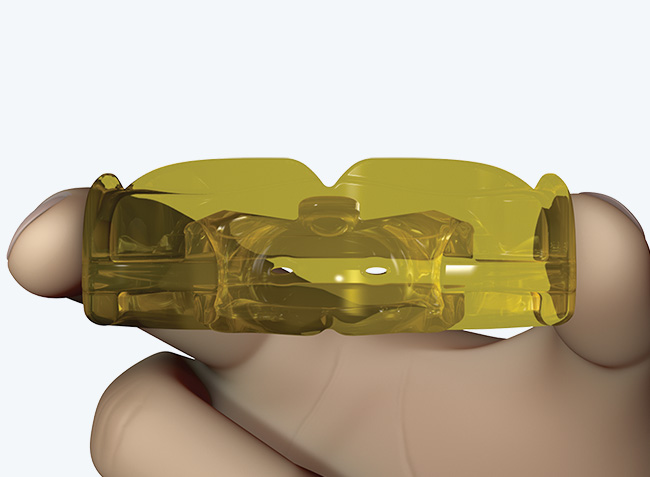
Flexible material
makes it a comfortable starting appliance, able to adapt to any arch form and malocclusion.

Small breathing holes
help to establish nasal breathing.
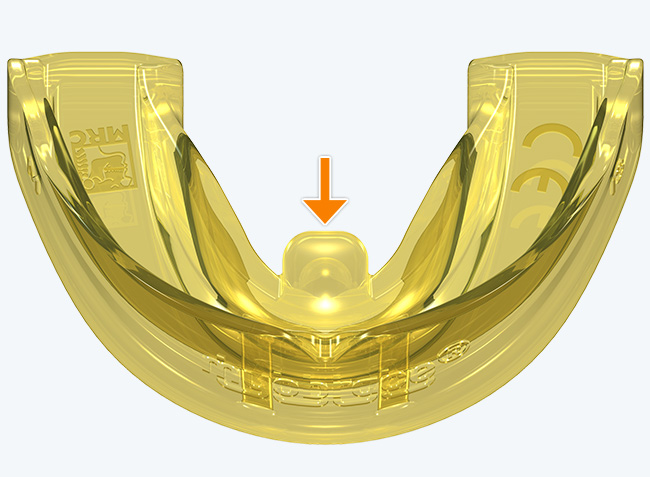
Tongue tag
encourages correct tip of the tongue positioning.
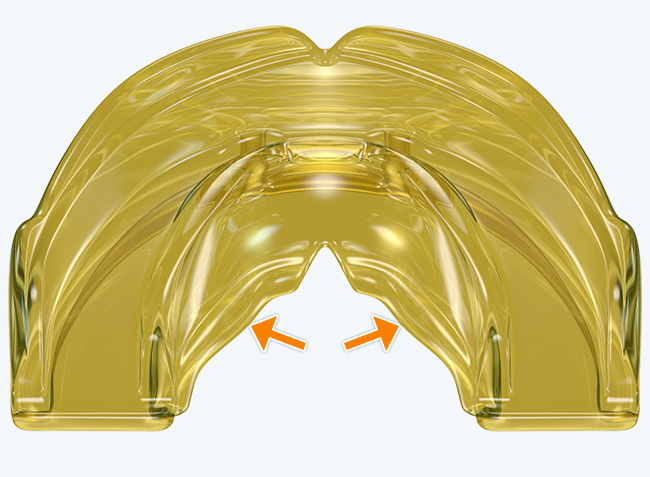
Tongue elevator
encourages the body of the tongue to rest in the roof of the mouth.
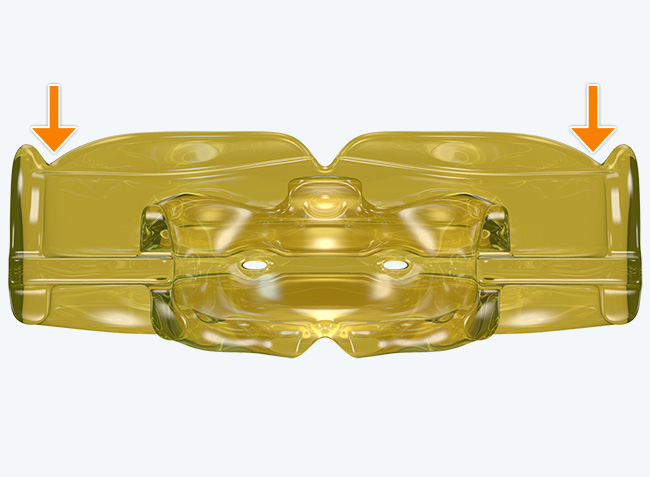
High sides
hold the soft tissues away, promoting arch development while optimising appliance retention.
Directions for Use
The Myobrace® appliance is to be used for one to two hours each day, plus overnight while sleeping. The patient's teeth may become slightly sensitive in the early stages of treatment. This is quite normal, however, if pain becomes excessive, decrease application time with the aim to build it back up once the appliance is accustomed to and sensitivity subsides.
Step 1
Hold the Myobrace® with the tongue tag facing up.
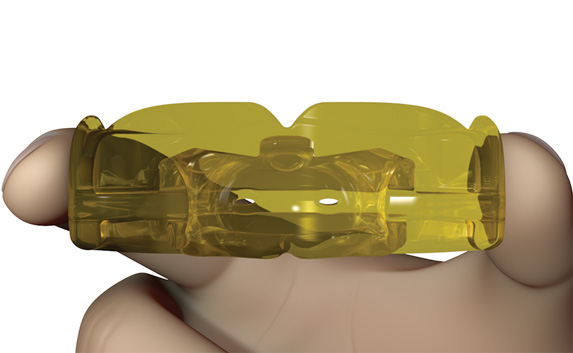
Step 2
Place the Myobrace® into your mouth.
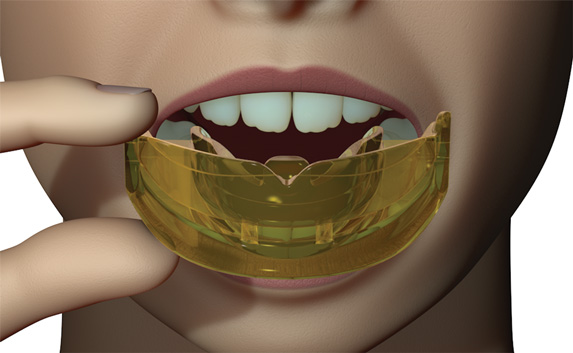
Step 3
Keep your tongue positioned on the tongue tag.
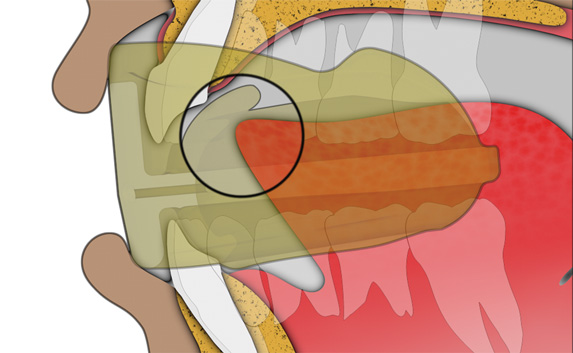
Step 4
Close down on the Myobrace® and feel it working to align your front teeth and jaws.
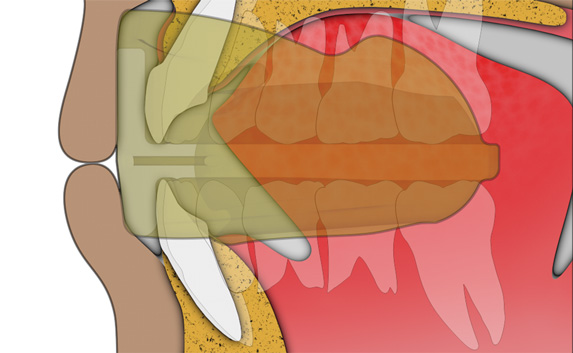
Step 5
Keep your lips together and breathe through your nose.
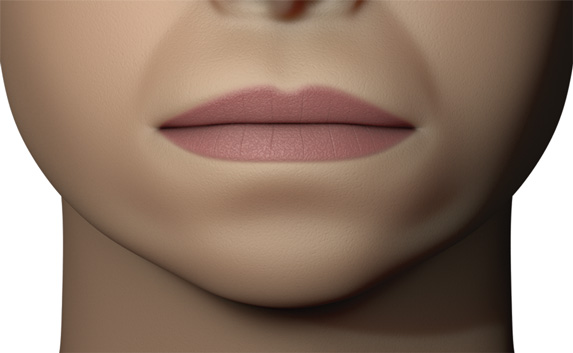
Cleaning the Appliance
The Myobrace® appliance should be cleaned under warm running water every time the patient removes it from their mouth.
Use Myoclean™ tablets to thoroughly clean twice a week. Myoclean™ is the recommended cleaning agent for all MRC appliances.
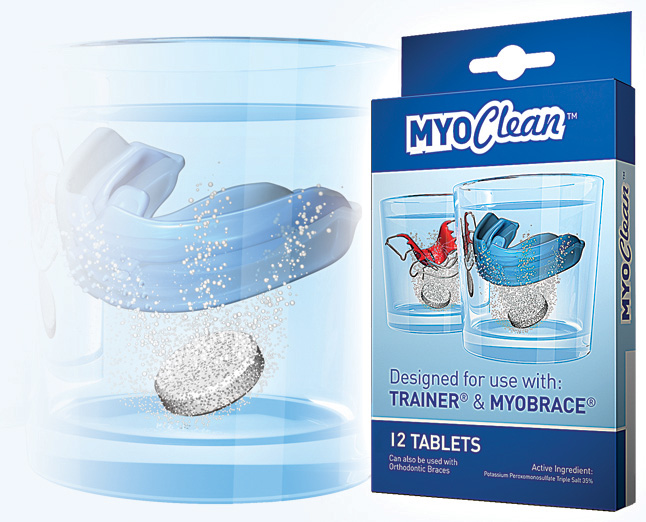
Case Studies
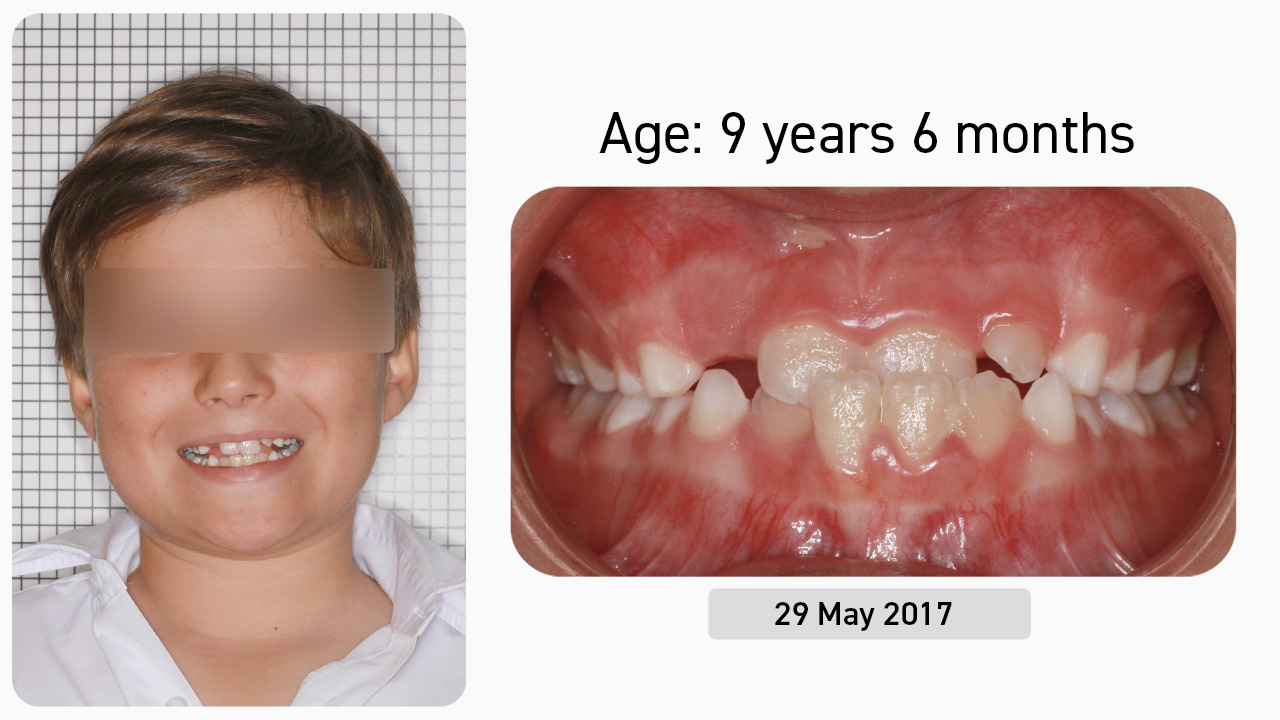
Case Study 1
This nine-year-old male patient presented with the chief complaint of an underbite and wanting to avoid braces. After being presented with the various treatment options, the decision was made to undertake Myobrace® treatment. This involved the use of a series of Myobrace® appliances combined with the Myobrace® Activities.
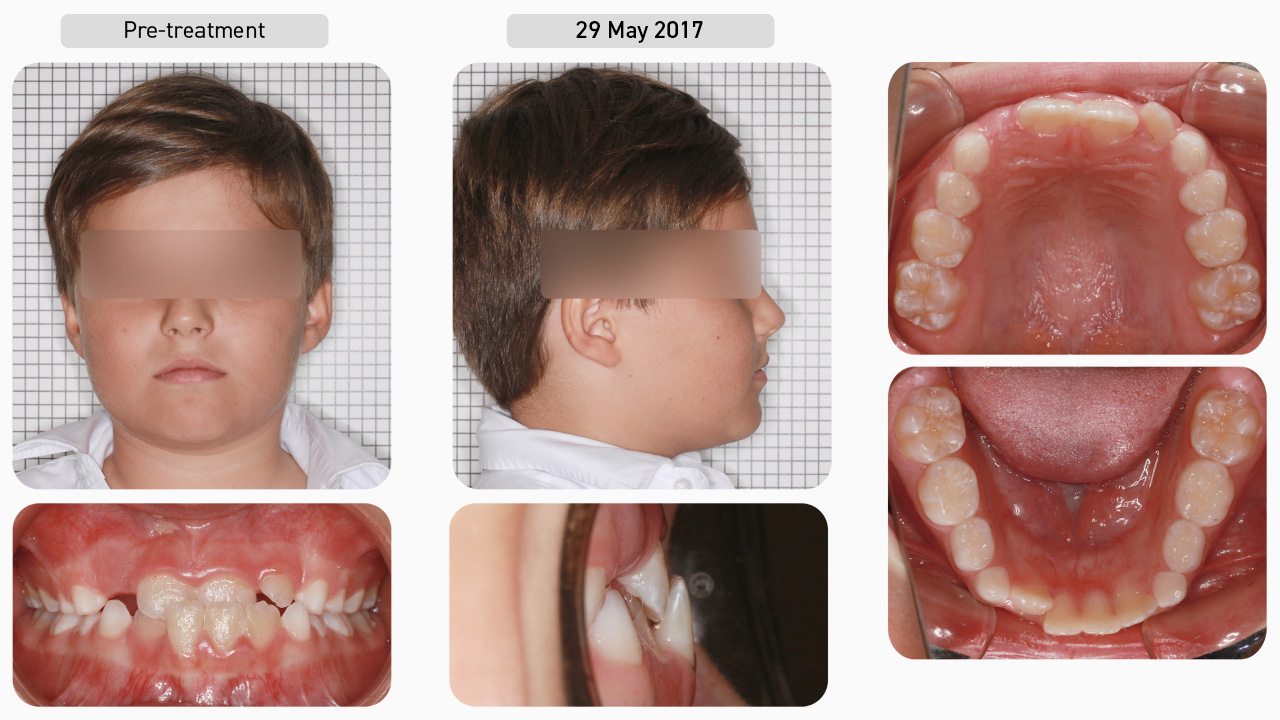
Pre-treatment
Using the Myofunctional Orthodontic Evaluation (MOE) form, we documented that this patient had a flattened upper arch with anterior crossbite and moderate dental crowding. This patient was a snorer and bruxer, and his poor myofunctional habits included mouth breathing with a low tongue posture and reverse swallow. Since he was in the mixed dentition with an anterior crossbite, his treatment began with the Interceptive Class III series.Using the Myofunctional Orthodontic Evaluation form, we documented that this patient had a flattened upper arch with anterior crossbite and moderate dental crowding. This patient was a snorer and bruxer, and his poor myofunctional habits included mouth breathing with low tongue posture and a reverse swallow. Since he was in the mixed dentition with an anterior crossbite, his treatment began with the Myobrace®Interceptive Class III series or i-3® series.
Dental Progression
He started with the i-3N appliance to establish nasal breathing and begin the correction of myofunctional habits. Once his breathing function had improved and he was consistently retaining the i-3N overnight (which took longer than usual due to subpar compliance), he was issued the i-3® appliance to focus on arch development and continued habit correction. At this stage, we would ordinarily employ the use of the BWS arch expansion appliance to enhance upper arch development and create space in the roof of the mouth to comfortably rest the tongue. However, it was at this stage that the patient's mother informed us that she did not want us to use anything that involved placing metal in the mouth, making the BWS (along with all other traditional arch expansion appliances) no longer an option. The decision was then made to use the P-3® appliance with absolute patient compliance to get as much improvement as possible, with the understanding that without the BWS, treatment would be compromised. The P-3® appliance was chosen because of its high reaching Frankel shields and because it is a firmer and more robust appliance than the i-3®.
Dental Progression
Good compliance with both Myobrace® wear and the Myobrace® Activities saw the upper arch slowly develop forward and the anterior crossbite resolve. The patient started with a medium P-3® appliance and, as the jaws developed, progressed onto the large P-3®. Notice the small spaces that have opened up mesial to the upper deciduous canines without the use of the BWS. This is because the upper arch has developed as a result of good function. These 'extra' spaces are needed to accommodate the soon to erupt permanent canines.
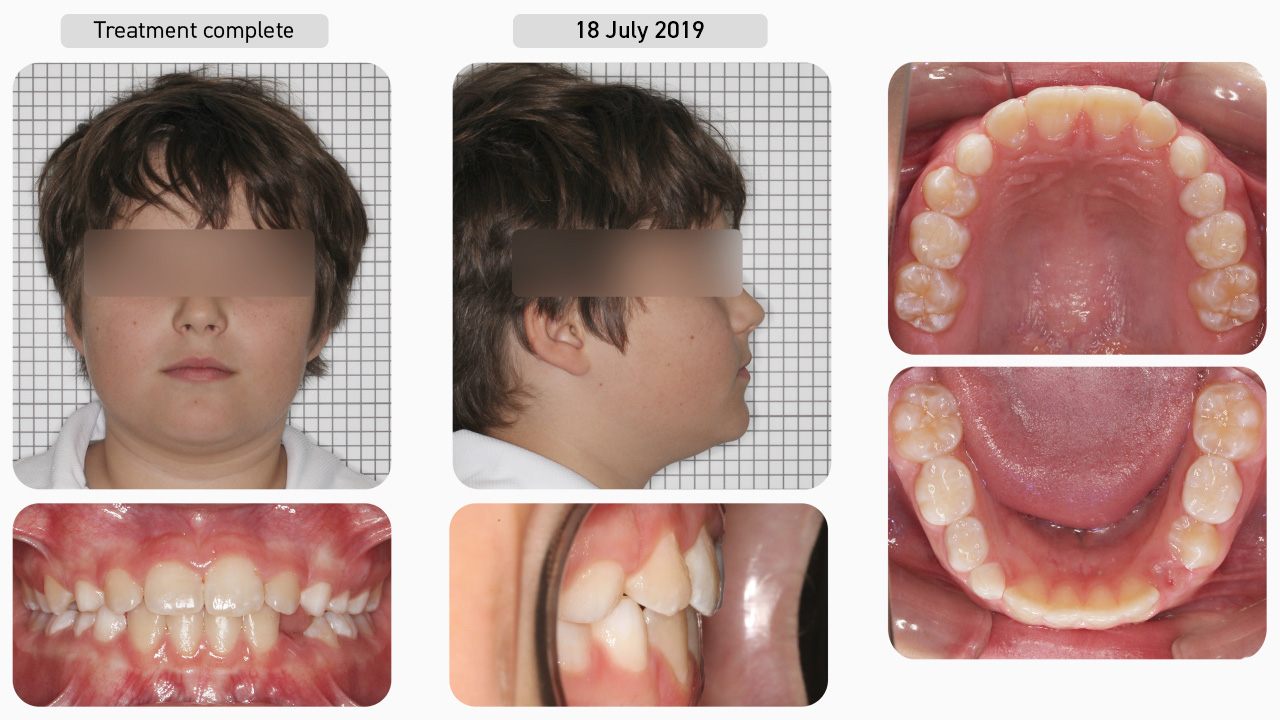
Treatment Complete
With good compliance, the goals of Myobrace® treatment were achieved, these were to establish nasal breathing, correct the myofunctional habits and attain good arch forms. The patient was then entered into the retention phase, continuing on the P-3® appliance to retain the arch forms, alignment and habits, ensuring that he could continue to develop correctly.
Facial Progression
With the breathing and myofunctional disorders having been corrected, the teeth not only aligned, but the airway improved and the patient was no longer snoring or bruxing. One year on, and the result has not only been maintained, but has continued to improve. With good breathing and muscle function established, we expect the patient’s remaining development to continue in a favourable manner.
Treatment Summary
Although we were unable to utilise BWS arch expansion in this case due to the parent being opposed to metal in the mouth, using the Myobrace® appliances in conjunction with the Myobrace® Activities, we have helped the patient to establish nasal breathing, correct his myofunctional habits and, therefore, achieve natural alignment of the teeth and correction of the anterior crossbite while establishing well-rounded arches. With the correct breathing and muscle habits maintained, we can expect further improvements in the teeth and jaws as the patient continues to grow.
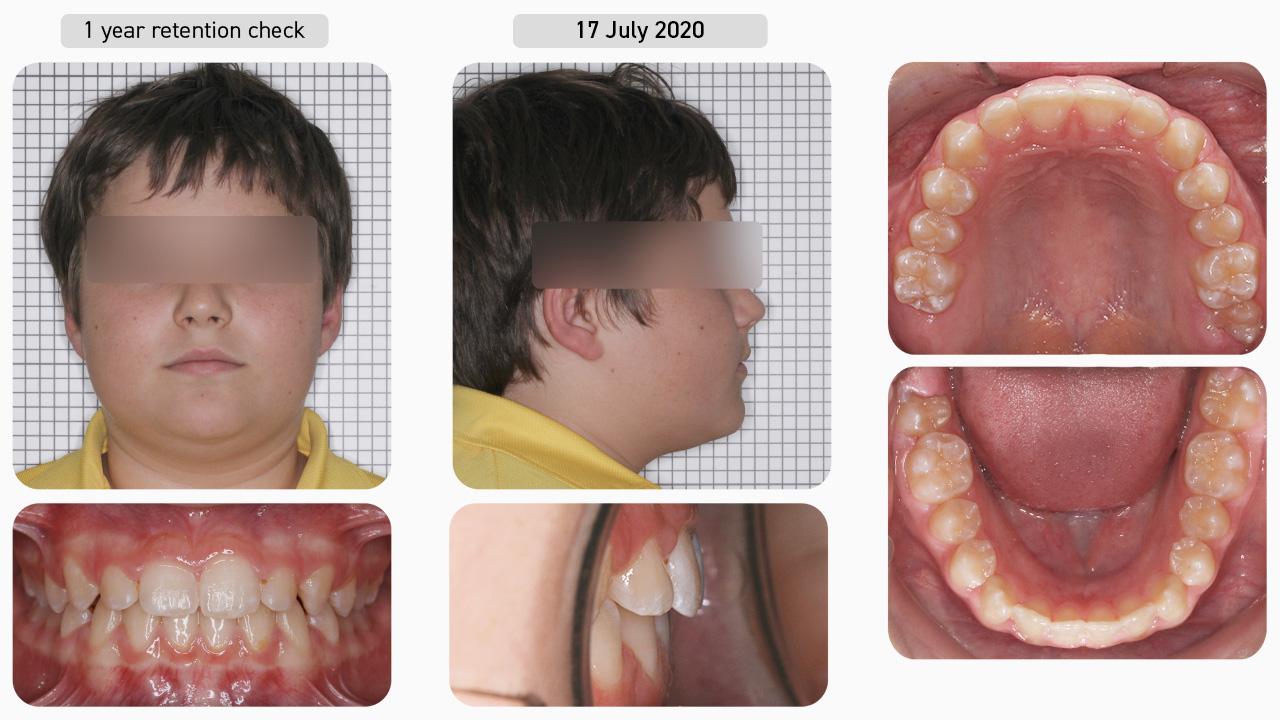
Retention
One year later, the result achieved has been maintained without the use of fixed retainers and, in fact, has improved with his continued use of the P-3® appliance. With correct breathing and myofunctional habits sustained, we expect this to continue further going forward.
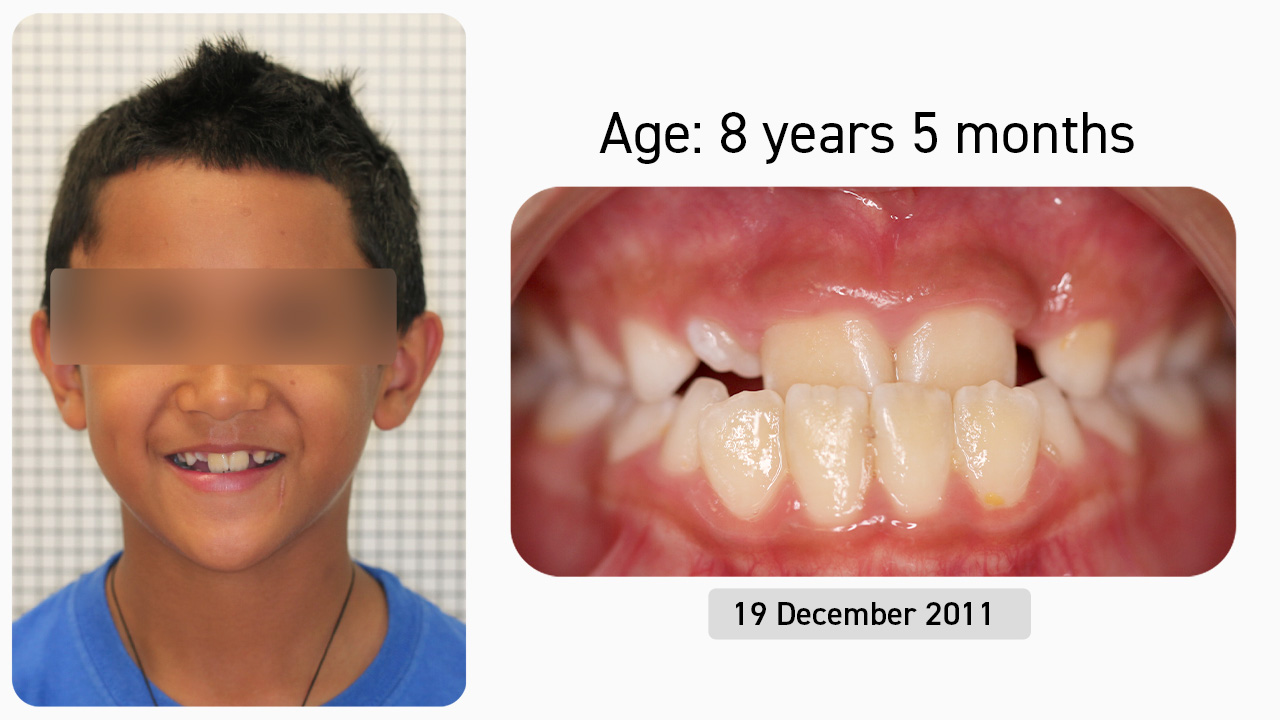
Case Study 2
This eight-year-old male patient presented with the chief complaint of an underbite with crowded teeth and wanting early intervention. After being presented with the various treatment options, the decision was made to undertake Myobrace® treatment. This case would require the Myobrace® appliances and activities to be used in conjunction with BWS arch expansion and Myolay™.
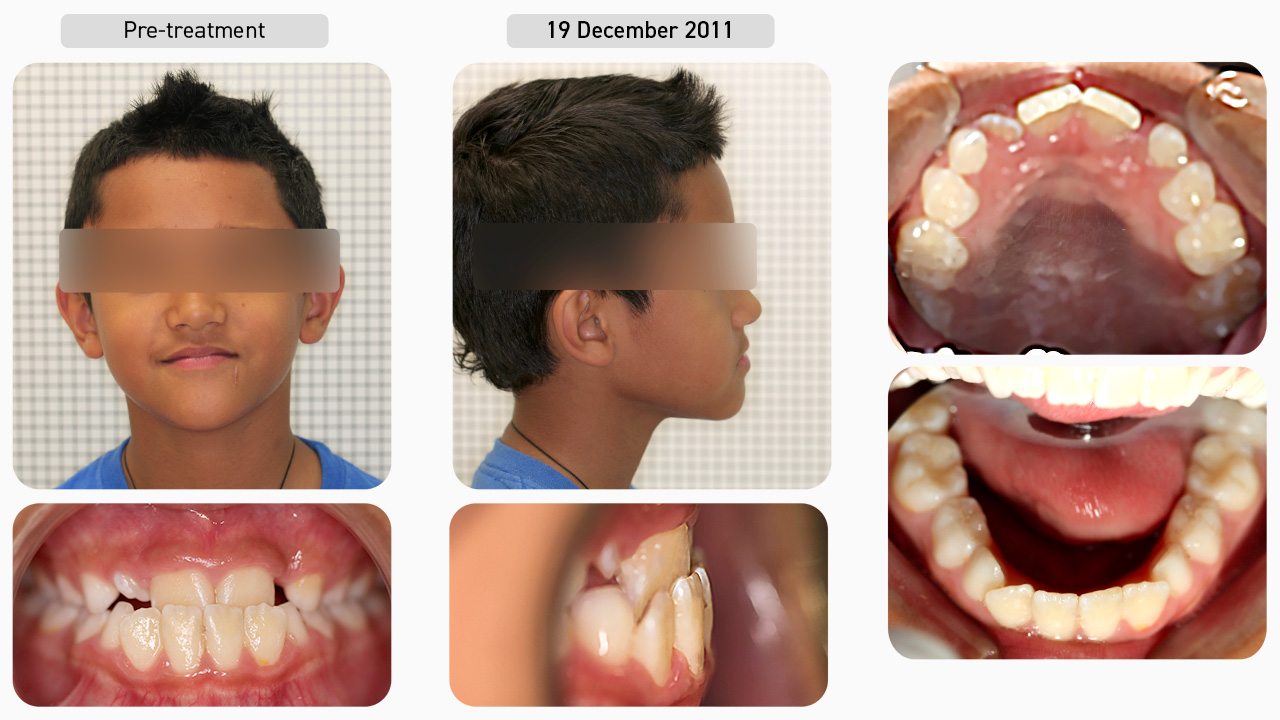
Pre-treatment
Using the Myofunctional Orthodontic Evaluation (MOE) form, we documented that this patient had a Class III malocclusion with severe dental crowding, in particular, lack of space for the upper lateral incisors. The facial profile was concave because of the underdeveloped maxilla, and the upper and lower arches were narrow and flattened anteriorly. His poor myofunctional habits included mouth breathing with low tongue posture and a reverse swallow. Since the patient had a Class III malocclusion in the mixed dentition, his treatment began with the Interceptive Class III (i-3®) series.
Dental Progression
This patient started with the i-3N appliance to establish nasal breathing and begin the correction of myofunctional habits. Three months later, his breathing function had improved and he was consistently retaining the i-3N overnight, so the decision was made to use Myolay™ and the BWS arch expansion appliance to ‘unlock’ the upper jaw from the lower jaw in order to enhance upper jaw development. Myolay™ composite was placed on the lower deciduous molars, and the BWS was fit in the upper arch. The BWS must be combined with a first stage appliance, so the patient remained in the i-3N appliance during this expansion. Once expansion was complete, the wire was removed and the patient got issued the i-3® appliance for continued arch development and habit correction.
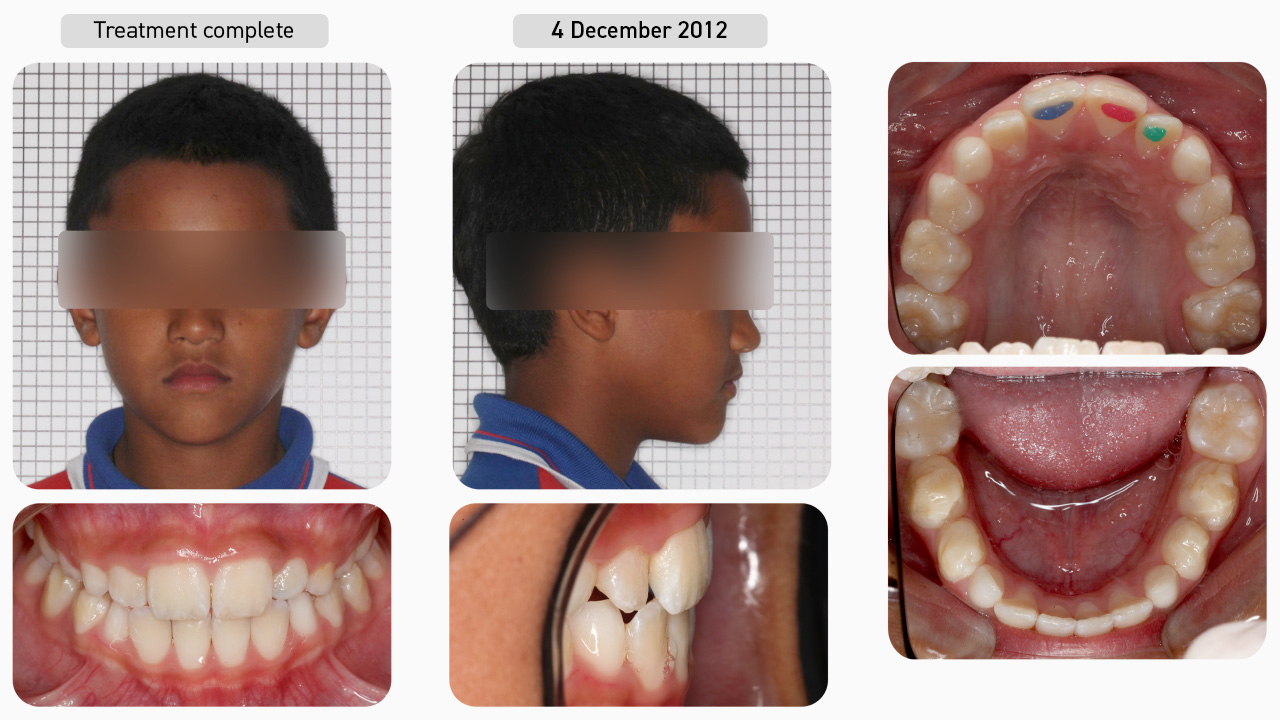
Treatment Complete
After just one year of treatment, the goals of Myobrace® treatment had been achieved (establish nasal breathing, correct poor myofunctional habits and improve the arch forms), so the patient entered into the retention phase of treatment. The i-3H appliance was issued to retain the arch forms, alignment and correct habits, so that he could continue to develop correctly. Note that although there have been significant improvements achieved, there is still some minor malocclusion remaining. It is important to understand that in Myobrace® treatment, this is not a concern because with the improved breathing and muscle function, we expect the teeth and jaws to continue to improve over time as the patient continues to grow. We are seeking natural alignment of the teeth and jaws, which occurs over time in the presence of good breathing and muscle function. Once you click through the remainder of the slides, you will see this in action!
Retention Progression
This patient was reviewed biannually to monitor his growth and the stability of the result achieved. Five and a half years after his treatment was complete, the arch forms, alignment and occlusion have improved further, and the result has remained stable because the correct breathing and muscle habits were established during his active treatment.
Facial Progression
With the breathing and myofunctional disorders corrected, significant improvements can be seen in the development of the face. The midface has developed forwards and the profile is no longer concave. With good breathing and muscle function established, we expect the patient’s remaining development to continue in a favourable manner.
Treatment Summary
Using the Myobrace®Activities and appliances in conjunction with Myolay™ and the BWS arch expansion appliance, we have helped this patient to establish nasal breathing, correct his myofunctional habits and, therefore, achieve natural alignment of the teeth and correction of the Class III malocclusion. The arch forms have improved and the teeth are well aligned, while the underbite has been corrected, all with good stability.
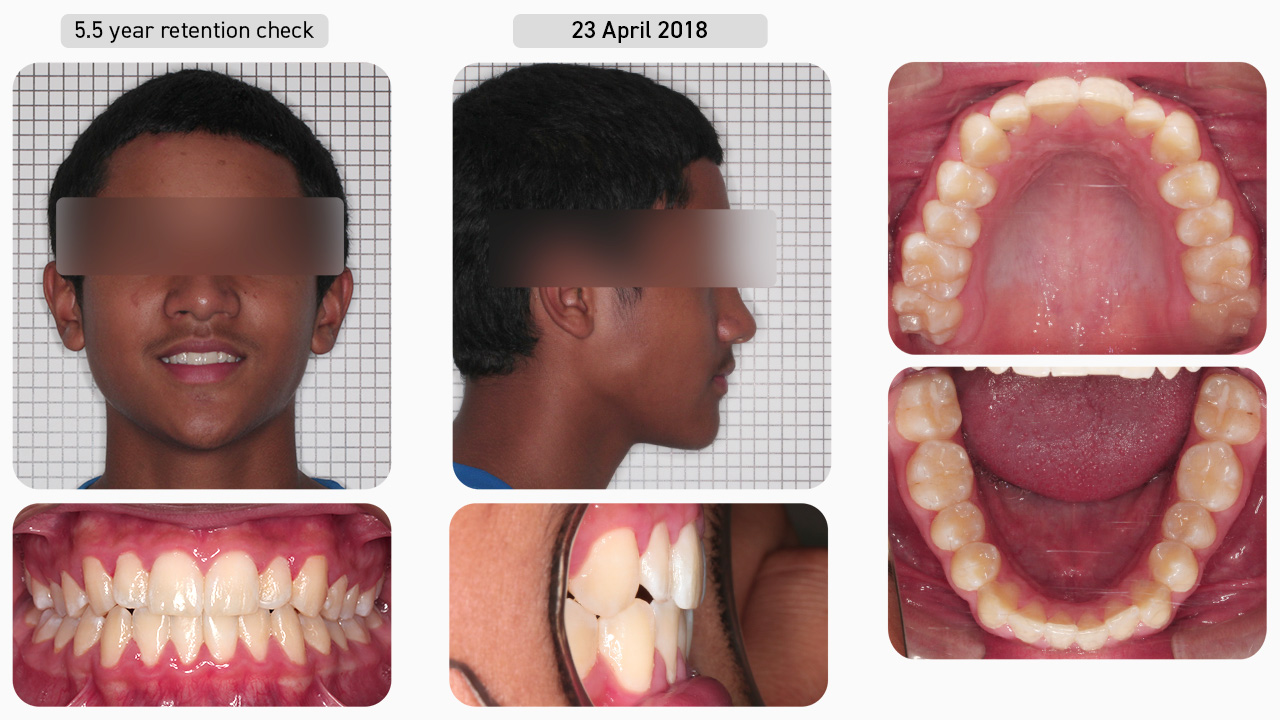
Retention
Good long-term stability relies on good breathing and muscle function. Approximately five and a half years after treatment was complete, the results have been maintained because the patient is nasal breathing with good tongue posture and a correct swallow pattern. The permanent dentition has erupted into well-developed arches and the jaws have developed in the right direction, resulting in a much-improved facial profile. With the correct breathing and muscle habits maintained, we expect good stability of the result to continue into the future.
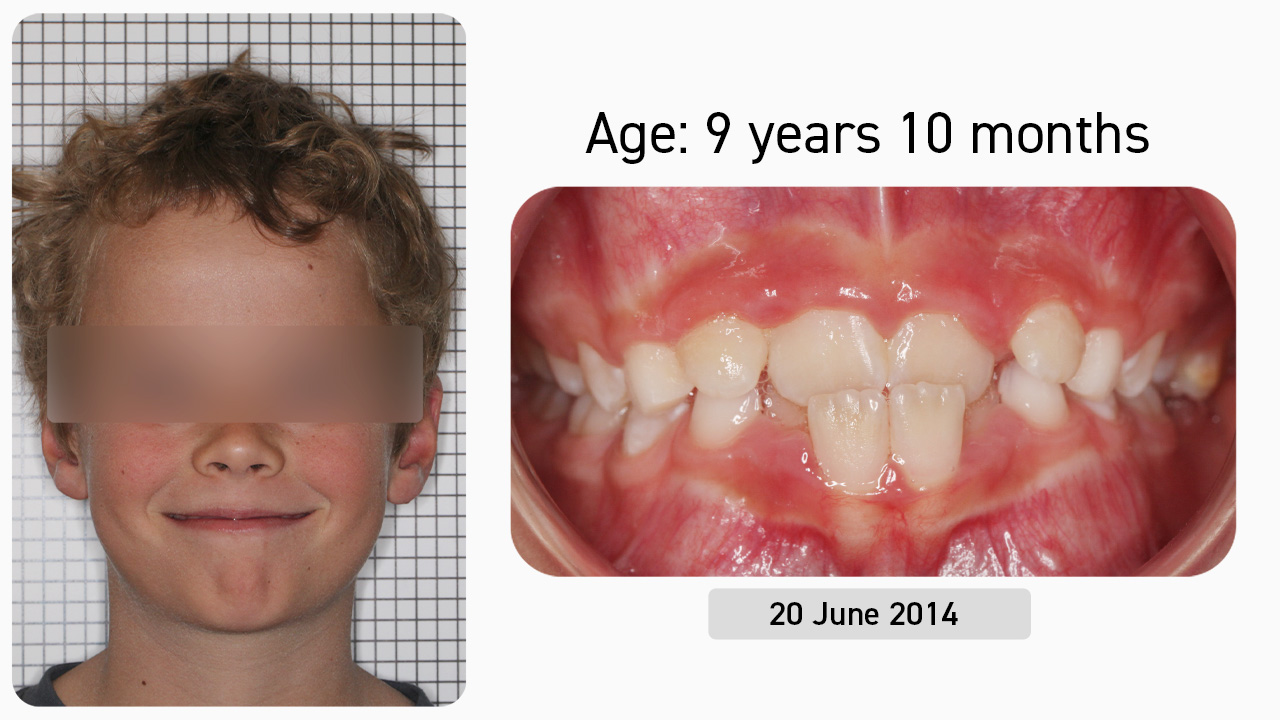
Case Study 3
This nine-year-old male patient presented with the chief complaint of crowded teeth and bruxism. As a result, he was self-conscious and apprehensive of smiling. After being presented with the various treatment options, the decision was made to undertake Myobrace® treatment. This involved the use of Myobrace® appliances combined with arch expansion and the Myobrace® Activities.
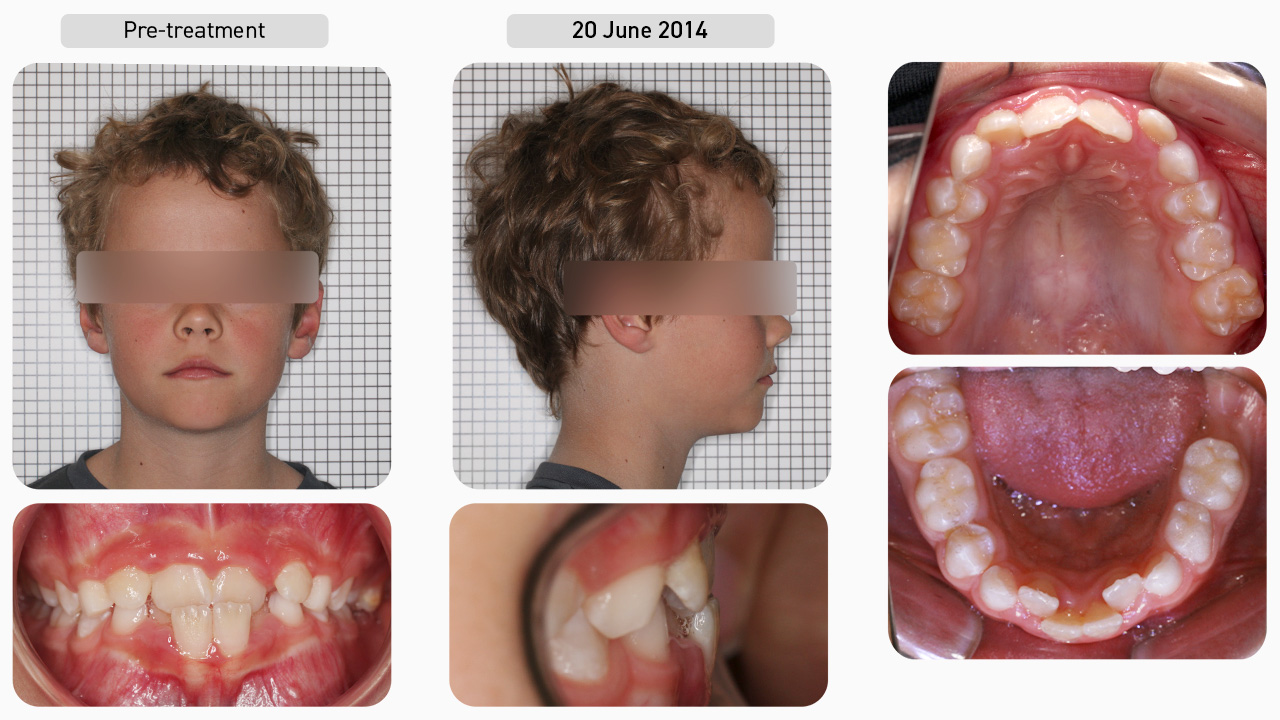
Pre-treatment
Performing a Myofunctional Orthodontic Evaluation (MOE), we noted that this patient had a flattened upper arch with anterior crossbite and moderate dental crowding. Previous dental history included extraction of the lower left first permanent molar (#36) due to caries with the hope that the second molar (#37) would take its place. This patient was a nocturnal bruxer, and his poor myofunctional habits included mouth breathing with low tongue posture and a reverse swallow. Since he was in the mixed dentition with an anterior crossbite, his treatment began with the Interceptive Class III (i-3®) series.
Dental Progression
This patient was first issued with the i-3N appliance to establish nasal breathing and begin the correction of myofunctional habits. You can see that the arch forms and dental alignment have already improved after less than three months of treatment. At this stage, his breathing function had improved and he was consistently retaining the i-3N overnight, so the decision was made to use the BWS arch expansion appliance to enhance development of the upper arch. The BWS must be combined with a first stage appliance, so the patient remained in the i-3N appliance during BWS expansion. Once BWS expansion was complete, the wire was removed and the patient was issued the i-3® appliance for continued arch development and habit correction.
Dental Progression
Once the anterior crossbite had been resolved, and a good overbite and overjet relationship of the anterior teeth was established, the patient was issued a K2 appliance. As he progressed from the mixed dentition to developing permanent, he was issued the T2 appliance for continued arch development and habit correction.
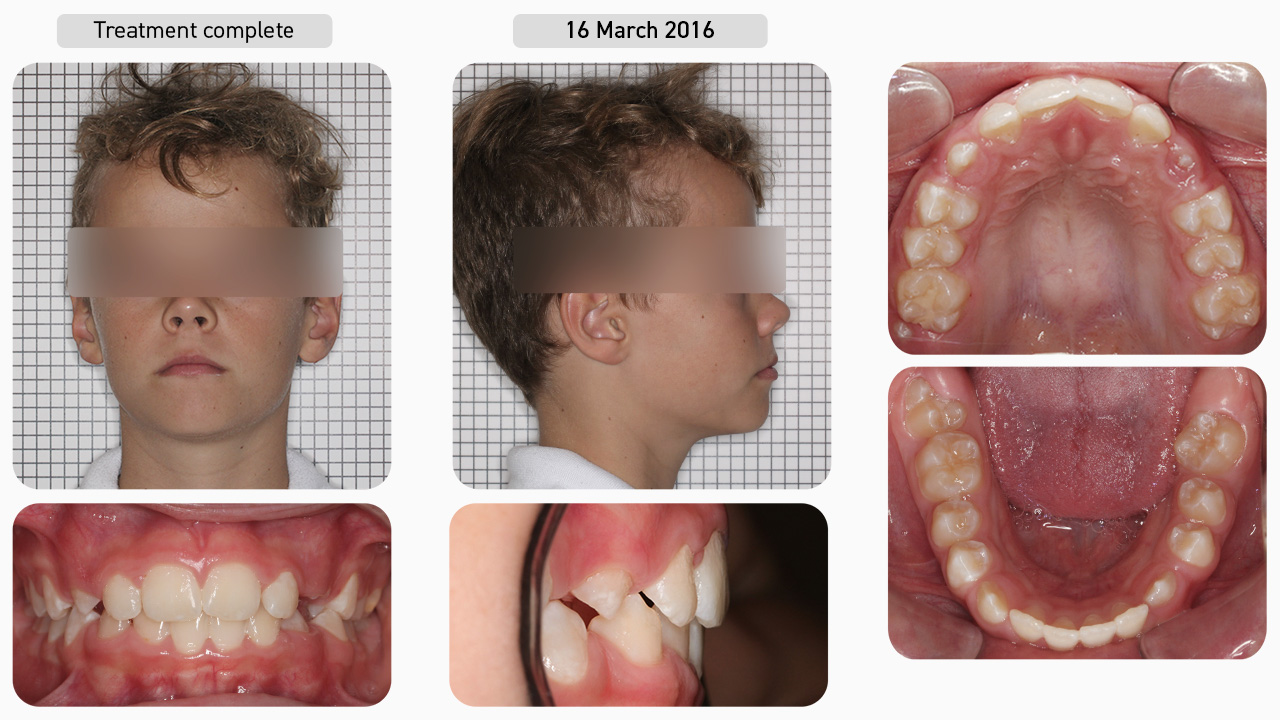
Treatment Complete
After less than two years of treatment, the goals of Myobrace® treatment had been achieved (establish nasal breathing, correct the myofunctional habits and attain good arch forms), so the patient was entered into the retention phase of treatment where the eruption of the permanent dentition and stability of the result achieved is monitored every six months.
Facial Progression
With the breathing and myofunctional disorders corrected, not only have the teeth aligned, but improvements can also be seen in the facial profile. The midface has developed, the mandible has moved forward, and both airway and posture have improved. With good breathing and muscle function established, we expect the patient’s remaining development to continue in a favourable manner.
Treatment Summary
Using the Myobrace® appliances in conjunction with the Myobrace®Activities and BWS arch expansion, we have helped the patient to establish nasal breathing, correct his myofunctional habits and, therefore, achieve natural alignment of the teeth and correction of the anterior crossbite. With the correct breathing and muscle habits maintained, we can expect further improvements in the teeth and jaws as the patient continues to grow and more permanent teeth erupt into the now well-developed arches.
Resources
Appliance Instructions
Downloadable pdf document with instructions specifically for the i-3N.
Download ResourceMyobrace® Appliance Catalogue
Downloadable pdf document detailing the Myobrace® appliance range.
Download Resource